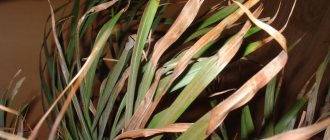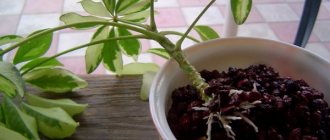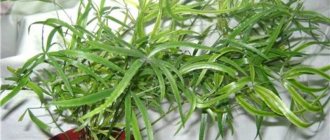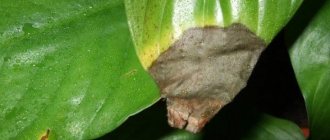Asparagus is a very beautiful indoor plant, loved by gardeners for its luxurious, lush greenery. However, if all the rules for caring for this flower are not followed, it may lose its beauty.
You can read more about caring for asparagus here.
Asparagus leaves often turn yellow and fall off, and the owners do not understand what the reason is. Yellowing of asparagus can occur due to many factors: untimely and improper watering, lack of lighting needed by this plant, low air humidity, lack of fertilizing and replanting.
In the article we will look at what to do if the asparagus leaves turn yellow and fall off, and also look at the popular reasons why this happens.
Why do asparagus leaves turn yellow and fall off?
Asparagus is famous for its unpretentiousness and endurance. However, sometimes he cannot stand it if he is not looked after properly.
Its small leaves begin to turn yellow and crumble. The plant loses its lush greenery and takes on an unpresentable appearance.
But not everything is so scary! The plant can be saved and returned to its former luxurious form. First you need to understand the causes of asparagus malaise.
The experience of knowledgeable gardeners suggests that there may be several reasons for the yellowing of leaves
- waterlogging of the soil;
- lack or excess of light;
- insufficient watering;
- indoor air is too dry;
- The root system had grown too much and it became cramped in the pot.
How to cure a plant?
If the asparagus have already turned yellow and fallen off , you need to cut off the bare branches and eliminate all possible causes of the plant’s malaise, that is, establish proper care for it.
Over time, the plant will again sprout young shoots and delight you with its delicate greenery .
If the asparagus gets sick in winter , by cutting off the affected shoots, you need to place it away from the radiators, reduce watering and at the end of winter transplant the plant into a new pot.
To choose the best shade-tolerant plants for your home, read our material.
Our article will tell you how to care for the pachira flower.
Find out about the features of caring for milkweed at home at the link: https://sad-doma.net/houseplants/trava/molochaj-uhod.html
The root system of the plant grows very quickly . Therefore, when replanting, you need to remove a third of its roots or divide the bush into two plants and, thus, acquire another asparagus .
to choose a wide pot for this plant .
Description and characteristics of asparagus
Asparagus belongs to the asparagus family. These are perennials with strong branching and predominantly needle-shaped branches. They can be herbs or subshrubs. They bloom in spring with small single or racemose inflorescences. After flowering, a berry is formed, inside of which there are one or more seeds. All asparagus berries are poisonous.
This genus includes 300 species growing in Eurasia, East and West Africa. Some of them are used as indoor plants because they have a short dormant period, and their branched structure gives them a decorative “fluffy” appearance. Some of them even decorate bouquets.
Causes of yellowness on leaves and their shedding
Yellowing of shoots and shedding of leaves in various indoor types of asparagus can be caused by a number of factors:
- Insufficient watering or, on the contrary, excessive soil moisture. Water deficiency inevitably leads to changes in the health and appearance of the plant. This is the most common reason for asparagus leaves falling off. But the constant presence of liquid in the pan and on the soil surface is also extremely destructive, because it provokes the occurrence of putrefactive processes in the root system and stem of the plant.
- Dry indoor air. Asparagus is native to tropical and subtropical forests. For this reason, even species adapted for growing indoors require high humidity. This problem is especially relevant in winter, when heating causes the air to become dry.
- Incorrect lighting. Although asparagus is a fairly light-loving plant, it is important to know that it does not tolerate direct sunlight. If they get on the shoots of a plant, they can cause serious burns and, as a result, the appearance of yellow and dry leaves, as well as their shedding. But excessive shadow will only cause harm to asparagus. A lack of sunlight makes the greenery sparse, and its shade dull and unattractive.
- Lack of fertilizers. Like any representative of living nature, an indoor flower needs nutrition. From soil and irrigation water that depletes over time, it is not possible to obtain all the substances necessary for proper nutrition.
- No periodic transplantation. The development of the asparagus root system is active, and a pot that is too small can be disastrous.
Feeding and new soil for sick asparagus
But sometimes the cause of the disease is not so obvious.
After all, even experienced gardeners do not always think that asparagus needs feeding, and they completely forget about timely transplantation of the crop - the plant is so hardy and unpretentious. The root system of asparagus is voluminous and quickly growing, so in early spring the plants are transplanted into fresh soil. At the same time, for young specimens it is better to carry out the procedure annually, and adult asparagus are transferred to a new container after 2–3 years. If the grower has forgotten about replanting the pet, the roots and tubers come to the surface, and the plant begins to experience an acute deficiency of nutrients and moisture. Asparagus will not turn yellow and crumble soon, but this will not have the best effect on the appearance and condition of the flower.
Replanting is also useful in that it helps to identify diseases and pests on the roots of asparagus that have not yet made themselves felt or have already caused the stems to dry out.
Fertilizing is carried out in spring and summer, and here you need to take into account that asparagus loves organic matter and nitrogen-containing mixtures, but an excess of this element can play a bad joke. A growth stimulator for greenery in a plant located in the shade causes shoots to stretch, and sometimes asparagus turns yellow due to excess fertilizer. Therefore, it is useful for your pet to choose a fertilizer with a harmonious content of all nutritional components and microelements.
Improper watering
The plant loves regular watering, so excessive drying of the earthen clod leads to the fact that it drops its leaves.
They first turn yellow and then quickly crumble. But it is not only water shortage that leads to such consequences.
and shoots of asparagus may begin to rot Therefore, you need to water the plant carefully, without drying out the soil or flooding it. And to prevent water from stagnating in the pot, you need very good drainage.
What to do with drying asparagus?
When the yellowness of the asparagus is not strong, for its recovery it is often enough to resume watering, remove the plant from the shade or, conversely, move it away from the sun, humidify the air or feed it. But a seriously ill asparagus plant needs special, comprehensive care. All lifeless stems are cut off from the drying asparagus, and then after pouring the earth well, it is useful to remove the plant from the pot and subject it to a thorough inspection.
Lack or excess lighting
Asparagus is a light-loving plant, but only diffused lighting is suitable for it. Therefore, if a flower is exposed to strong sun for at least 1 hour a day, it may develop burns that look like dry or yellowed leaves.
And if asparagus lacks light due to its location in the shade, then its leaves will soon become dull, faded and will also soon turn yellow and fall off. Therefore, you need to keep asparagus in diffused light so that the sun's rays do not fall on it .
The air is too dry
Asparagus is a resident of the tropics, so it is best adapted to existence in humid air.
If the air around the plant is too dry, the flower quickly reacts by drying out and curling its leaves. It all starts with the edge of the leaf drying out, which then turns yellow and after a while curls and falls off.
To maintain the health and beauty of the plant, it should be sprayed in the summer heat and in winter, when the heating devices are turned on. This will increase air humidity and provide the plant with optimal living conditions.
Why does a flower wither?
Even such an undemanding green pet as asparagus can suddenly become ill. In this case, various symptoms are detected:
- loss of shoot color saturation;
- the leaves, or rather the cladodes (transformed stems) that replace them, turn yellow;
- the green mass becomes covered with spots;
- the branches dry up;
- the plant begins to crumble.
Most often, the cause of such troubles lies in errors and omissions associated with flower care. Their consequences are usually eliminated without much difficulty. The plant will be able to recover, you just need to create optimal conditions for this. Sometimes this is possible even in cases where the above-ground part cannot be saved - the surviving rhizomes produce young shoots .
Humidity
The plant loves moist air; its dryness is one of the main reasons for yellowing and falling of asparagus.
In summer, the branches must be sprayed with settled water from a sprayer.
The most favorable time for this is in the morning at dawn or in the evening at sunset.
Occasionally you can take a bath in the bathroom under the shower. During the procedure, the soil is protected with a bag from tap water getting into it.
Makeup for a corporate party - interesting ideas for different tastes! (70 photos)
What to do to save an indoor flower?
In order to save the plant, it is necessary to create suitable conditions and provide the plant with appropriate care.
- The best place to place the flower would be a window that faces south, east or west.
- It is necessary to maintain high ambient humidity. This is an important criterion in growing asparagus. Frequent spraying is required. Especially in hot summer, or during the heating season. It is useful to take a warm shower and leave the flower in the bathroom overnight. In winter, asparagus is placed away from radiators and other heating devices. It is recommended to use pallets with wet moss, pebbles or expanded clay.
- In summer, asparagus needs regular and moderate watering - two to three times a week.
The top layer must dry before moistening. In winter, watering no more than once a week, or even less often, depending on the air temperature in the room. Do not allow water to stagnate in the pot. - From spring to autumn, your green friend needs regular feeding. Fertilize once every two weeks with complex fertilizers.
- The flower needs to be replanted on time. Young plants - once a year, adults (after 5 years) - as the pot fills with roots. Without harming the asparagus, you can remove part of the overgrown rhizome.
To preserve the decorative appearance, branches with yellowed and crumbling foliage can be trimmed.
What to do if the plant turns yellow and the leaves fall off
If the asparagus leaves begin to turn yellow and fall off, in order to save the plant, it is important to take care of it and correct the growing conditions, since the health and appearance of the flower depend on them.
Branches on which the foliage has turned yellow and fallen off need to be cut off. This will allow the plant to direct its energy to the development of new shoots. Soon the bush should produce new young branches.
If a flower gets sick in winter, after pruning it should be removed away from heating appliances and watering should be reduced. At the end of winter, it is recommended to transplant the asparagus into a more comfortable pot.
If the problem is in a very overgrown root system, it can be cut off by 1/3 when replanting. Another option is to divide the bush into several parts and plant each of them in a separate pot.
By establishing the correct watering regime, choosing a place with diffused lighting, creating high humidity in the environment and carrying out regular fertilizing, there is no doubt that asparagus will again delight the eye with its lush green foliage!
Diseases, pests and methods of control
The causes of oppression can be pests and diseases. Among the insects that infect the plant, it is worth highlighting aphids, scale insects and spider mites.
- Aphid. Penetrates with wind currents and new flower crops. It is a carrier of viral and infectious diseases. It is easily detected when examining the lower parts of the leaves. The main symptom is the appearance of a whitish coating. Aphids feed on juices, and waste products make it difficult for plants to breathe, causing fungal diseases. Before treating with a chemical, it is wiped with a damp sponge and soapy water. Treatments with infusions of hot pepper, garlic or onion solutions are popular as traditional methods. Of the chemicals used, Fufanon is used. "Aktellik", "Fitoverm", "Karbofos".
- Spider mite. It gets into houses with gusts of wind, with earth or tools. There are red, orange or yellow individuals. It reproduces most actively in dry and hot weather, at temperatures above 30 degrees in both summer and winter, when heating devices dry out the air. Characterized by the formation of a thin white cobweb. To destroy the flower, cover it generously with soap foam and place it in a plastic bag to create a greenhouse effect. The most effective drugs are Fitoverm, Karbofos, Actellik. A folk remedy is practiced: 30 g of onion peels are infused in a liter of water for 5-6 hours. The finished solution is filtered and the flowers are sprayed over the entire surface. For preventive purposes, it is necessary to maintain the air temperature no more than 20-23 degrees and periodically spray.
- Shield. A small insect with a grayish color. The reasons for the appearance are dry air and elevated temperatures. It can be detected by convex growths of a white or brown hue or along leaf veins. It feeds on juices, causing infectious diseases. Rubbing with an alcohol solution is practiced, after which the flower is thoroughly washed with water. Of the fungicides, the effect of using “Golden Spark”, “Kondifor”, “Aktara”, “Mospilan” is noted. They are mostly removed manually.
- Thrips. Small dark-colored insects prefer oppressed and weakened plants that were poorly fertilized or grew in insufficient light. Characteristic signs: whitish paths on the foliage, twisted stems, deformed leaves. Affected flowers have reduced immunity and are more susceptible to disease. Effectively use fungicides “Condifor”, “Aktellik”, “Vertimek”, “Karbofos”. Among the folk remedies, infusions of hot pepper, celandine, and yarrow should be noted. For prevention purposes, plants are sprayed and sticky traps are placed near the pots.
- Chervets. In appearance it resembles woodlice. Pests attack plants with an insufficient level of care: at low temperatures, excessive watering, and putrefactive processes on plant debris. It gets into a house with other crops and contaminated soil. Recognized by a whitish coating resembling cotton wool. Feeds on juices, slowing growth. For destruction, the drugs “Condifor”, “Mospilan”, “Calypso”, “Aktara” are used. You can fight scale insects with a soap solution or garlic infusion. For prevention, you should follow the recommendations for watering, arrange periodic sprinkling, and promptly remove yellowed and dried branches and leaves.
As a preventative measure, plants are regularly irrigated from a shower head, after covering the soil surface. It is necessary to ventilate the premises, avoiding drafts. Periodically inspect the plantings, checking for the presence of pests and diseases. Monitor the temperature and quality of the soil, and the irrigation regime.
Important! The most common disease is gray mold. A gray coating, characteristic of the disease, appears in case of high humidity. In most cases this happens in autumn and winter. Treatment with copper oxychloride and stabilization of the temperature eliminates the problem.
Following basic care recommendations and regular examinations can prevent diseases or take urgent action.
How to control asparagus pests
Asparagus is sick due to pests that can parasitize the flower even indoors. The symptoms described above can be caused by microorganisms, so it is worth studying them in detail to be sure of the cause of the disease.
Spider mite
A very small parasite that is not immediately noticeable. May be colored red, orange or yellow. Spider mites are often confused with ordinary spider mites due to their similar structure. It is worth noting that spider mites parasitize only on plants and cannot cause any harm to humans.
Did you know? Spider mites live on all continents except Antarctica.
A tick can enter an apartment or house through an open window (with raindrops or a gust of wind), along with tools or soil.
The pest loves dry air and hot weather. Air temperature directly affects the rate of reproduction (at a temperature of +30 ˚C, the laid larvae hatch within two days). The appearance of the pest can occur both in summer and in winter (heating in the house dries out the air and creates optimal conditions).
How to understand that a plant is affected by spider mites?
An incomprehensible transparent web will appear on the asparagus (in this case, you should not blame indoor spiders, since this is the very first sign of mite infestation). Small yellowish spots form on the leaves, which then merge into several larger ones.
Similar symptoms can be observed with sunburn, so carefully inspect the plant before baiting the pest. If left unattended, spider mites will eat away all the beneficial substances from the plant. The leaves will turn yellow and the plant will dry out.
The asparagus is sick, covered with spots and dries out due to the activity of the mite, what to do? It is difficult to treat a plant with chemicals, since insecticides indoors are very dangerous for humans and domestic animals.
Try traditional methods:
- Treat the plant with a solution of laundry soap. Lightly moisten the leaves and shoots with soap foam, being careful not to get them on the ground.
- Garlic infusion. Take 20 g of garlic peel per 1 liter of water and infuse for five hours. Next, the solution is sprayed onto the entire plant.
If all else fails, you will have to use chemicals, since the mite can move on to other plants. The most common fungicides against spider mites are Fitoverm, Karbofos and Actellik.
Preventing the appearance of mites is to maintain high humidity in the room or regularly spray the asparagus (but not water it!).
Thrips
Small insects that are up to 5 mm long and have a dark body color. The parasite is distributed throughout the world and has more than 6 thousand species.
The pest appears on a weakened plant that has not been watered for a long time, kept in a poorly lit room, or not fed.
Symptoms:
- the appearance of whitish “paths” on the leaves;
- faded spots on leaves;
- deformed leaves or flowers;
- curvature of the stem.
If the damage is severe, then the asparagus branches will begin to dry out and the leaves will wither. Thrips are dangerous because they reduce the plant’s immunity to various diseases and prevent it from growing and developing normally. If the pest population reaches its maximum, they will simply “eat” the asparagus.
Fungicides are used for treatment, namely: “Vertimek”, “Aktelik”, “Confidor” and “Karbofos”.
Important! Asparagus does not react well to chemicals, so choose a weak one so as not to destroy the plant.
Thrips can be driven out using folk remedies. To do this, the plant is treated with decoctions of celandine, capsicum and yarrow.
Prevention measures:
- spraying asparagus;
- inspection of the flower for the presence of parasite larvae;
- placing yellow sticky traps near or on the plant.
It is impossible to completely get rid of thrips, but prevention and proper care will minimize damage to asparagus.
Aphid
A small insect from the order Hemiptera. Aphids attack almost all plants, not disdaining indoor flowers.
You can bring aphids home with a bouquet of flowers or a new plant from a flower shop. An insect can also travel through the air and enter an apartment through an open window. The parasite attaches itself to the asparagus and begins to drink the juices. In addition to direct damage, aphids also carry dangerous viral and bacterial plant diseases.
If asparagus is infected by aphids, then soon its leaves will begin to curl and become deformed, and the flowers will dry out without blooming. A lack of nutrients can result in leaves becoming discolored or drying out. The waste products of aphids remain on the asparagus, making it difficult to breathe. Aphid excrement attracts various types of fungi, which will also interfere with the plant.
Aphids can be treated using both traditional methods and chemicals.
To remove the pest, you can use the following infusions and decoctions:
- Garlic or onion infusion. For 1 liter of water, take 30 g of garlic and 4 g of laundry soap, leave for at least eight hours. After this, asparagus is processed several times with an interval of 10-12 days.
- Treatment with pure alcohol. Wipe the entire above-ground part of the asparagus.
- Spraying with infusion of hot capsicum. Boil 100 g of fresh pods in 1 liter of water for about an hour. After this, the broth is diluted with water in a ratio of 1: 10.
Folk remedies do not always work, so it is better to use proven drugs, such as Fufanon, Karbofos, Fitoverm and Actellik.
Prevention measures:
- proper care;
- frequent inspection of the plant;
- fertilization;
- spraying from a spray bottle.
Chervets
The parasite belongs to the family of Homoptera insects. In appearance it looks more like a white woodlouse or some kind of beetle (hairy louse - popularly called a scale insect), has a length of up to 6 mm and is similar to a scale insect. Parasites appear on asparagus due to poor care (low temperature, excessive watering, rotten plant debris). The scale insect can also be brought into the house with contaminated soil or plants.
It can be recognized by a white coating that resembles cotton wool or fine snow. Affected leaves turn yellow and become deformed. Like aphids, hairy louse leaves excrement on the plant, on which fungus develops.
Did you know? Some species of scale insects are used to produce dyes and varnishes.
The pest is dangerous because it sucks the juices of the plant and slows down its growth. Only huge colonies of this parasite can cause asparagus to dry out.
It is not difficult to cure the plant. In the early stages, the flower is treated with a soap solution several times at intervals of a week. If the entire bush is covered with parasites, then you need to resort to chemicals: “Aktara”, “Calypso”, “Mospilan”, “Confidor”.
Fighting scale insects with traditional methods:
- Alcohol infusion with soap. For a liter of water, take 15 g of liquid soap and 10 ml of denatured alcohol. Spray the plant with the resulting mixture.
- Garlic infusion. Take 5 cloves of garlic for a half-liter jar of water. Boil water and steam the chopped garlic. After this, filter, dilute 1: 5 with water and process the asparagus.
Prevention measures:
- do not over-moisten the soil;
- Carry out regular checks for the presence of pests;
- remove dry leaves and shoots in a timely manner;
- shower and rinse the leaves.
Shchitovka
The pest belongs to the hemiptera family. The scale is up to 3 mm long and grayish-white in color. The main reason for the appearance is dry air and high temperature. Scale insects can also be brought home on another plant or bouquet.
Symptoms:
- small light growths in places where the leaves adhere to the shoots;
- plaque along the leaf veins;
- yellowing and premature falling of leaves.
Don't underestimate these microscopic pests. The scale insect causes significant harm to the plant (a large colony can easily destroy even a large tree). Since the parasite feeds on the juices of the plant, damaging the integrity of the shoots, the asparagus loses nutrients and cannot breathe normally. Another infection gets into the wounds, which brings a “bouquet” of other problems and diseases.
You need to fight the scale insects and you can’t delay it. Asparagus can be treated using both traditional methods and insecticides.
Important! Do not forget that the plant does not tolerate chemicals very well and should be used as a last resort!
The most common insecticides that will quickly remove scale insects are Aktara, Mospilan, Confidor and Zolotaya Iskra.
However, it is worth knowing that it is impossible to remove adult scale insects by treating them with insecticides, so the only option is mechanical removal. To do this, use a cotton pad soaked in an insecticide solution. Do not forget to also irrigate the above-ground part of the plant with water. Often due to dry age, this disease occurs.
Each disease looks for a weak spot in the plant, so the best prevention is proper care. Feed the asparagus in a timely manner, remove dry and rotten parts, monitor the room temperature and air humidity. Slightly moist soil is the key to plant health. Do not forget about drafts and sudden changes in temperature, which asparagus does not like. Replant and divide the flower in time to not only speed up the growth of asparagus, but also to get another young plant.
Follow the principle: “comprehensive care is the best medicine.”
Asparagus is a popular plant among home gardeners. You can often find that asparagus begins to turn yellow and crumble. Such a nuisance can be dealt with and cured by eliminating the causes that led to the disease and illness of the flower. Let's consider what to do if your indoor pet gets sick.
Basic rules of care
Among indoor plant lovers, asparagus is one of the most popular. Asparagus is a flowering plant, but since its flowers look completely unpresentable, the main decorative function belongs to the leaves, reminiscent of luxurious fern branches. True, in place of the flowers, red berries appear, which, due to their color, contrast well with the greenery of the asparagus.
With proper care, asparagus can bear fruit.
But in order for the plant to bear fruit and please the eye with its bright color, you need to adhere to some simple rules of care:
- The air temperature should not exceed 20°C in summer, and in winter it should not be lower than 10°C. Asparagus does not like excessively warm air; it likes a temperate climate.
- Increased air humidity promotes plant growth. Therefore, you must not forget about regular spraying with clean water. Especially in hot weather and during the heating season.
Rules and regulations for feeding calves from the first days of life
Do not place the flower near batteries. You can leave asparagus in the bathroom from time to time after you have bathed in it and there are a lot of moist particles left in the air. It is also practiced to place asparagus on a tray with wet pebbles.
Asparagus feels great on the window.
- The lighting should be bright and necessarily diffused. Direct contact of leaves with the rays of the sun is unacceptable, as this may be one of the reasons why asparagus turns yellow. It is best to place it near windows facing south, west or east.
- Watering is one of the main processes in growing asparagus. The correct water regime is moderately moist soil; under no circumstances should it be allowed to dry out. From spring until autumn it should be watered evenly. Let the soil dry out a little between waterings. In cold winter, watering should be more moderate. It will be a good idea to periodically water the plant through a tray.
- Pruning occurs only when yellowness appears on the asparagus. Leaves that have lost their attractiveness are removed.
- The soil must be mixed. The required substrate is obtained by mixing equal parts of peat, turf and leaf soil, humus and sand.
- Proper nutrition. Like any other plant, asparagus constantly needs nutrients. That is why it needs to be fed 2 times a month with mineral fertilizers. And in spring and summer it is necessary to add fertilizers to the soil for decorative deciduous plants.
Return to contents
Asparagus develops a root system very quickly, which requires replanting.
For this cute plant, timely replanting is a very important point in care. The root system of asparagus develops very quickly, so it needs a spacious, wide pot.
A young plant should be replanted annually, and then as soon as the pot is completely filled with roots. If you do not plan to divide the bush into several parts, you need to use a large pot for replanting.
In this case, you need to carefully remove the flower from the old pot and clean its roots from the old soil. If necessary, you can remove some of the overgrown roots. Place drainage at the bottom of the new pot, add a layer of soil and place the plant, then add soil until the pot is full and water a little.
After transplantation, each plant experiences stress. Asparagus is no exception, so it will need some time to adapt to new conditions. During this period, you should not water or feed the plant. Place it in a dimly lit place for 5-7 days, and then begin to gradually return the plant to its usual proper care.
Room care mistakes
The variety is light-loving, so it does not like to be in dark places.
Watering
It is necessary to water asparagus moderately . Excessive accumulation of moisture in the soil, as well as overdried soil, is not recommended. Too much moisture can cause rotting of the root system.
In addition, with constantly increased moisture in the soil, the likelihood of the appearance and reproduction of insects, bacteria and fungi that are harmful to flower growth increases.
On the other hand, you need to monitor the frequency of watering so that the soil does not become stony . Despite the fact that the asparagus root system is capable of storing nutrients and water “for reserve,” reserves may run out.
Try not to let the earthen ball dry out completely.
Depletion without moisture leads to the cessation of flower growth.
Thus, if the plant is watered too often or, conversely, has not been watered for a long time, the watering regime should be adjusted.
It is recommended to follow the following rules for watering the flower:
- Water according to weather conditions and room temperature.
- Inspect the soil in the pot to make sure watering is necessary.
- Loosen the soil , giving the roots access to oxygen.
- Place drainage at the bottom of the pot, which will help remove excess water.
You should not pour water into the pan; if it comes into excessive contact with the roots, they can rot, and the pet can get sick and crumble.
It is also necessary to monitor the air humidity in the room where the flower is located. If indoor air is dry, the leaves may begin to turn yellow. When the air humidity is low, it is recommended to periodically spray the plant .
Lighting
Sunlight is necessary for any plant to synthesize the necessary elements. If there is a lack of sunlight, the leaves may begin to turn yellow and it will not grow well. In this state, the plant is susceptible to the development of diseases.
In such cases, it is necessary to move the asparagus to the sunny side , where it will receive maximum light.
However, it should be borne in mind that excessive midday sunlight may cause spots on the leaves - burns. Such leaf burns are extremely undesirable, since damage occurs to the organs responsible for photosynthesis.
Thus, it is necessary to remove the plant from the scorching sun in time, without allowing it to dry out.
Treating sunburn on leaves is quite simple . It is necessary to move the plant into the shade, humidify the air and fertilize the flower.
Direct sunlight will burn the foliage
Season of the year
When caring, you should also take into account the season of the year.
In winter, the plant rests. You should reduce the number of waterings and try to protect them from drafts and hypothermia.
In spring, asparagus begins active growth . During this period it should be fertilized with mineral fertilizers. It is advisable to replant the flower in a larger pot in the spring to allow it to grow rapidly.
Transfer
In spring, it is recommended to replant the plant in fresh soil. In addition, it is advisable to prepare a larger pot for asparagus , since this flower has a rapidly growing root system.
If there is insufficient area for roots to grow, they will begin to come to the surface, and the plant will lack moisture and nutrients.
No transfer
Some inexperienced gardeners forget to replant asparagus, others consider it unnecessary when the plant is regularly fed.
This is not true. The plant's root system quickly grows and becomes cramped in the old pot. And for this reason, the flower slows down its growth and loses its leaves.
Everything indicates that the plant is depressed. To prevent this from happening, asparagus must be replanted regularly in mid-spring . Young plants require annual replanting, adults - once every 2-3 years.
It is not easy to understand the reasons for the yellowing of asparagus leaves. First you need to analyze the conditions of its detention. If errors are evident, they must be corrected immediately to return the plant to a healthy green appearance.
Transfer
The signal for replanting is the sprouting of roots from the holes in the pot.
A young plant needs to be replanted annually - its roots grow very actively and quickly fill the entire container.
As soon as the flower is 4-5 years old, it is enough to replant it once every 2-3 years. If asparagus is not planned to be propagated by division, then with each procedure the pot is selected 2-3 centimeters larger than the previous one.
Moderate root trimming is allowed. A thick layer of expanded clay drainage is poured into the bottom of the new pot, and the soil is mixed from two parts of leaf and humus soil and one part of sand.
Within 5-7 days after transplantation, the plant adapts to the changed conditions and recovers from the stress it suffered. During this period, it is best not to feed it, not water it, or expose it to bright light.
Other problems
Growers who grow asparagus have to deal with all sorts of problems. Each of them can have several possible causes. Measures to resuscitate a pet depend on its condition.
If the growth of a flower has stopped, this may be caused by a lack of nitrogen and iron, poor watering, pest damage, or the need for replanting. The drooping appearance of the plant indicates a lack of moisture or its excess. In the latter case, you need to remove the rotten roots and transfer the asparagus to dry soil, ensuring reliable drainage.
If the green mass has lost its rich color, then you need to pay attention to the light level. During the period of active growth it should be maximum. Cladodes can also turn pale as a result of a lack of nitrogenous components. Feeding the bush with the appropriate mineral composition will help here.
When spots appear on the leaves, it is not necessarily due to parasites. The same symptoms can appear due to sunburn. In such a situation, the flower needs to be provided with light shading, fertilizing and abundant irrigation.
Preventive measures against diseases
The best preventive measure against the appearance of many asparagus diseases is to follow all the rules for caring for the plant:
- Carry out timely fertilizing that strengthens the plants well.
- Monitor the temperature and humidity in the room, provide the necessary lighting.
- Remove dried and rotten parts.
- Provide proper watering.
- Carry out timely replanting, as well as divide the roots to renew and obtain new indoor plants.
- Inspect plants for any diseases or pests. If a problem is detected, take appropriate measures to eliminate it in a timely manner.
- For planting and replanting flowers, use only disinfected soil.
- When propagating, use only strong and completely healthy specimens.











